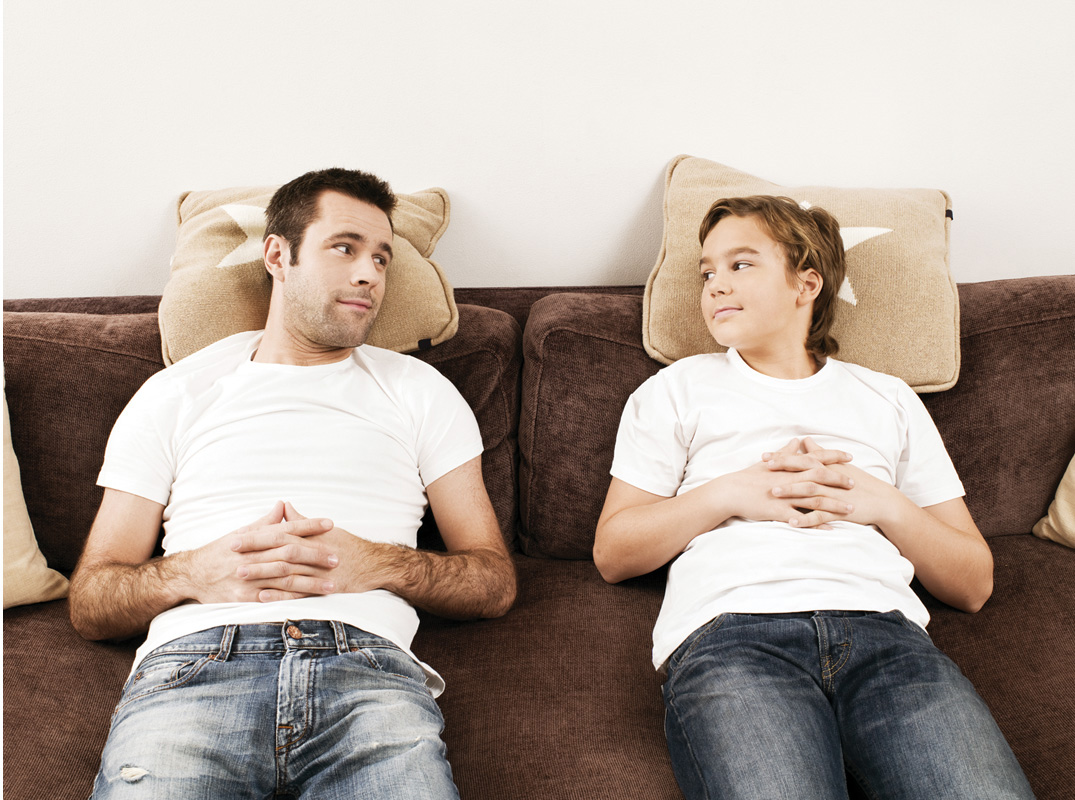7.1 Learning From Others
Like other animals, humans learn by experiencing associations between stimuli (classical conditioning), such as the bell and the food for Pavlov’s dogs (Pavlov, 1927). If every time we see Tim, we have a good time, our association of Tim with good feelings may lead us to develop a positive attitude toward Tim and seek out his company. We also learn to repeat behaviors that in the past have been followed by favorable outcomes and avoid behaviors that have had unfavorable outcomes (operant conditioning). If every time we tell a joke, our friends praise us, we will become more likely to tell additional jokes. In addition to these forms of learning, we humans also learn a great deal by garnering information from others and from observing others and imitating their behaviors.
Social Learning Theory
An old expression captures the basic idea of social learning: “Monkey see, monkey do.” Plenty of animals learn this way, not just monkeys. Birds learn songs from other birds. Untrained dogs learn faster if they are taught behaviors alongside dogs who are already trained (Adler & Adler, 1977). Research in Italy has even shown that octopi are faster at learning how to open a jar to get food if they first had an opportunity to observe another octopus do it (Fiorito & Scotto, 1992). However, we humans are probably the species most reliant on social learning. The renowned teacher of psychology Henry Gleitman put it this way:
Social learning
The capacity to learn from observing others.
[I]n the course of a lifetime, human beings learn a multitude of problem solutions that were discovered by those who came before them. They do not have to invent spoken language or the alphabet; they do not have to discover fire or the wheel or even how to eat baby food with a spoon. Other people show them. (Gleitman, 1981, p. 498)
From driving a car and hitting a tennis ball to eating sushi or doing the tango, we learn largely from watching others model those behaviors. In fact, we saw in chapter 4 that certain neurons, called mirror neurons, are activated both when one does an action oneself and when one simply observes another person perform that action (Uddin et al., 2007). As the neuroscientist Marco Iacoboni notes, “When you see me perform an action—

Albert Bandura’s classic Bobo doll studies illustrate how we learn our behaviors by watching others. Here we see that the adult’s (top panel) aggressive actions are subsequently modeled by both boys and girls.
[Dr. Albert Bandura]
In Bandura’s seminal studies (Bandura et al., 1961, 1963a, 1963b), mildly frustrated nursery school children (between ages three and six) watched a film of a young woman punch and kick a large inflated Bobo doll and hit it with a mallet. Children readily imitated this behavior when they were later given an opportunity to play with the Bobo doll, punching and kicking the doll and hitting it with the mallet in a manner that was eerily similar to the model’s behavior, right down to repeating the same aggressive remarks that the model had made (e.g., “Pow, right in the nose, boom, boom.”). Similar results occurred whether the film showed a live-
233
Does the tendency to imitation also occur in adults? The next time you find yourself at a restaurant, take a look at the people at other tables. How often do you see people mirroring each other’s posture—
Chameleon effect
The tendency to mimic unconsciously the nonverbal mannerisms of someone with whom you are interacting.

Like father like son? People often mirror the posture and mannerisms of those they are talking to. Sometimes mirroring conveys warmth and contentment, but other times shared animosity.
[Holloway/Getty Images]
To document the chameleon effect, the researchers paired each participant with a partner and had them take turns telling a story about a photograph. The participants performed this task twice, with two different partners. Unknown to the participants, these partners actually were confederates of the experimenters and had been trained ahead of time either to rub their faces or shake one of their feet at certain times during the interaction. They had also been trained to smile or remain neutral during the interaction. The interactions were videotaped and later coded by judges, according to how often the participants rubbed their faces or shook a foot. As expected, when doing the task with a face-
Additional research shows that this kind of mimicry isn’t limited to casual, nonverbal behaviors. People also automatically shift their attitudes toward what they think another person’s opinions might be, especially when they are motivated to get along with that person. To show this, one study (Sinclair et al., 2005) had White participants complete an implicit association test (the IAT, which we introduced back in chapter 3) to measure their automatically activated attitudes toward African Americans in the presence of an experimenter who was wearing a T-
234
The researchers predicted that people would shift their attitudes toward the attitude of the experimenter, but only if they liked her. Compared with the blank T-
The role of liking suggests that mimicry often may happen because most social interactions involve a general goal of trying to get along. Unless they are truly disagreeable, most people go into an interaction with a stranger with the goal of being liked. Our group-
APPLICATION: Harmful Media-inspired Social Learning

|
APPLICATION: |
| Harmful Media- |
However, this aptitude for social learning has its downside. The sociologist David Phillips (1974, 1979) discovered that media portrayals of celebrity suicides are associated with subsequent increases in suicides and car accidents among the general public. Philips also showed that the more media coverage suicides get in a particular region of the country, the more people tried the act themselves. Feature films also often inspire unfortunate examples of social learning. The award-
Social Priming
Observing others perform an action does much more than merely provide a model. Such exposure also communicates information about our social world. Thus, another basic way that people influence us is by priming ideas, norms, and values. For instance, watching someone engage in aggression makes aggressive concepts more accessible (Bushman, 1998). As we saw in chapter 3, when concepts are made salient or more accessible, they are more likely to influence our behavior. When other people remind us of the norm to be fair or to be charitable, for example, often we are more likely to act in accord with those norms.
Robert Cialdini’s (2003) focus theory of normative conduct emphasizes the important role that salience plays in enhancing the influence of norms. This theory distinguishes between two different types of norms. Injunctive norms are beliefs about which behaviors are generally approved of or disapproved of in one’s culture. Descriptive norms are beliefs about what most people typically do. Often the two norms align. For instance, people generally think that motorists should stop at red lights and that most of them do. However, norms can also diverge. People also think that others should not litter but believe that most people do. In studies directed toward decreasing littering and increasing energy conservation and recycling, Cialdini and colleagues have found that reminding people of either type of norm regarding these behaviors, whether through exposure to another person’s behavior or to a posted sign, tends to increase adherence to the norms.
APPLICATION: Using Norms to Preserve

|
APPLICATION: |
| Using Norms to Preserve |

How can norms be used to reduce theft of wood from Arizona’s Petrified Forest National Park?
[Getty Images/Gallo Images]
There is a danger to using norms to change behavior. Cialdini (2003) has noted that well-
Injunctive norm
A belief about what behaviors are generally approved of or disapproved of in one’s culture.
Descriptive norm
A belief about what most people typically do.
235
Social Contagion
The ideas of both mimicry and social priming may also help explain a phenomenon that Gustave Le Bon (1896) labeled social contagion: that ideas, feelings, and behaviors seem to spread among people like wildfires. Le Bon noted how people in crowds come to behave almost as if they were of one mind. Since his time, studies have shown that everything from yawns, laughter, and applause to moods, goals, and depression seems to be contagious, spreading easily from person to person (e.g., Aarts et al., 2004; Hatfield et al., 1993; Provine, 2004). For instance, when participants were given the goal of remembering an emotionally neutral speech, they became happier if the voice was slightly happy and sadder if the voice was slightly sad (Neumann & Strack, 2000). Even obesity seems to be contagious. The medical researchers Christakis and Fowler (2007) analyzed data on body-
Social contagion
The phenomenon whereby ideas, feelings, and behaviors seem to spread across people like wildfire.
236
APPLICATION: Psychogenic Illness

|
APPLICATION: |
| Psychogenic Illness |
One particularly remarkable form of social contagion is called mass psychogenic illness (Colligan et al., 1982). This phenomenon occurs when an individual develops physical symptoms with no apparent physical cause, which then leads other people to feel convinced that they too have the same (psychologically generated) symptoms. Instances of this phenomenon seem to date at least back to the Middle Ages (Sirois, 1982). In one fairly well-

|
Learning From Others |
| Humans learn a great deal by observing and imitating others. | ||
|---|---|---|
|
Social Learning
|
Social Priming |
Social Contagion |